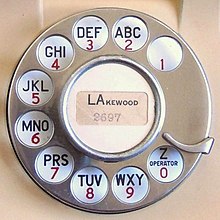
A telephone exchange name or central office name was a distinguishing and memorable name assigned to a central office. It identified the switching system to which a telephone was connected, and facilitated the connection of telephone calls between switching systems in different localities.
While small towns and rural areas might each be served by a single exchange, large cities were served by multiple switching systems, either distributed in the community constituting multiple exchange areas, or sometimes hosted in the same building to serve a densely populated area. Central offices were usually identified by names that were locally significant. The leading letters of a central office name were used as the leading components of the telephone number representation, so that each telephone number in the area was unique. These letters were mapped to the digits of the dial, which was indicated visibly on the dial's numbering plate.
Several systematic telephone numbering plans existed in various communities, typically evolving over time as the subscriber base outgrew older numbering schemes. A widely used numbering plan was a system of using one or two letters from the central office name with four or five digits. Such systems were designated as 2L-4N or 2L-5N, or simply 2–4 and 2–5, respectively, but some large cities initially selected plans with three letters (3L-4N). In 1917, W. G. Blauvelt of AT&T proposed a mapping system that displayed three letters each with the digits 2 through 9 on the dial.[1]
Telephone directories or other telephone number displays, such as in advertising, typically listed the telephone number showing the significant letters of the central office name in bold capital letters, followed by the digits that identified the subscriber line. On the number card of the telephone instrument, the name was typically shown in full, but only the significant letters to be dialed were capitalized, while the rest of the name was shown in lower case.
Telephone exchange names were used in many countries, but were phased out in favor of numeric systems in the 1960s. In the United States, the demand for telephone service outpaced the scalability of the alphanumeric system and after introduction of area codes for direct-distance dialing, all-number calling became necessary. Similar developments followed around the world, such as the British all-figure dialling.
- ^ M. D. Fagen, ed. (1975). A History of Engineering and Science in the Bell System: The Early Years (1875-1925). Bell Telephone Laboratories. p. 578.
© MMXXIII Rich X Search. We shall prevail. All rights reserved. Rich X Search
